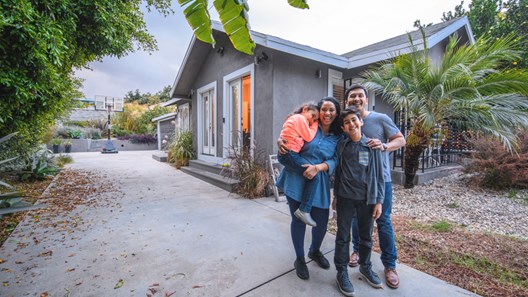Introducing Purchase Perks! Save $1,000 on closing costs when you purchase with us.
Whether you're looking for a new home, refinance your existing property, or get cash from your home's equity, we've got customized loans for your needs. Talk to a loan officer today.
Americans are on the Move: Here are the Top States for Home Buyers
Read Time: 3 Minutes
|June 7, 2021
According to Redfin Chief Economist Daryl Fairweather, the recent increase in home prices is being fueled by both high demand for homes and rising home prices. “We expect 2021 to be an even more active year for the housing market than 2020 because homebuyers have a better sense of what the future looks like. Employers are providing clarity on permanent remote-work policies, the economy is recovering, and mortgage rates remain low. A lot of wealth from the coasts is shifting South. Affluent homebuyers from New York and San Francisco have moved to places like Florida and Texas during the pandemic.”

States Seeing Promising Housing Market Forecasts
The same Redfin report indicated that the South is expected to see the biggest increase in new home buyers with $1.09 trillion of home sales forecast for 2021. The West is second with $696.3 billion, the Midwest with $422.6 billion, and the Northeast trails with $322.8 billion.
Cheapest States to Live In
Citing an ALEC economic outlook ranking, U.S. News & World Report stated that “states that have eschewed income taxes and capped spending have the best economies “these include the red states of Utah, Florida and Texas. At the opposite end of the spectrum are blue states such as New York and California, which have what are considered "progressive" income tax policies.”
Oracle and Tesla announced late last year that they will be moving their headquarters to Texas from the Silicon Valley area in California. According to the Wall Street Journal the announcements “have highlighted the vastly different tax and regulatory systems in the country’s two most populous states. California relies more on taxing personal income, particularly of high-income households, and operates a growing regulatory structure. Texas leans on more regressive property and sales taxes and boasts a more laissez-faire
Median Home Value by State
Here are the top 20 States sorted by lowest Median Home Value based on data from World Population Review:
#1 - 5: Mississippi, West Virginia, Arkansas, Oklahoma, Kentucky
#6 - 10: Indiana, Alabama, Ohio, Iowa, Kansas
#11 - 15: Michigan, Nebraska, Missouri, South Carolina, Louisiana
#16 - 20: South Dakota, Tennessee, New Mexico, Texas, North Carolina
environment.”
Popular States to Move to: Texas and Florida
“Texas and Florida and a few other states have been really the big gainers in terms of net population growth,” says Frank Nothaft, chief economist at real estate data firm CoreLogic.
According to the U.S. Census Bureau, those two states added a combined 600,000 people and accounted for more than half of the nation’s population growth over the year. Texas added an estimated 373,965 residents from mid-2019 to mid-2020. Florida grew by 241,256 people in a year.
Arizona, North Carolina, and Georgia rounded out the top five states for population growth. The five states that lost the most population were Pennsylvania, Michigan, California, Illinois, and New York.
Time for a Smart Move.
Honorable Mentions: Utah, Arizona, Idaho, and Montana
The recession created by the coronavirus sent residents of Northern California and Seattle fleeing to Utah in great numbers causing the housing market there to go from hot to scorching hot. Dave Robison, owner of goBE Realty and president of the Utah Association of Realtors said the situation in Utah is “insane.”
Montana is experiencing a “Zoom Boom” for new housing that could last years. According to Billings real estate broker Mark Dawson, “it appears that the buyers are coming from outside of Montana, and not just California.” In Idaho the situation is similar. The median sales price in Ada County, ID hit a new record of $469,250 in March, rising by more than $100,000, or nearly 28%, in just one year. Meanwhile, in 2020, Arizona jumped from 19th to 5th place among U.S. states as a destination for people to move to.
Prices and Rates are Going Up
Doug Duncan, Fannie Mae’s chief economist recently cautioned about rising inflation and a rise in interest rates, “This could lead to prices rising further…the question then becomes whether this necessitates a response by the Federal Reserve…this is an increasingly important consideration for 2022.”
And from Investment Week, “should inflation continue to rise, many expect that the Federal Reserve will be forced to act and further hike rates.” The Federal Reserve does not determine mortgage rates; however, their decisions affect them because they govern how much banks pay to borrow funds. This could in turn affect how much mortgage lenders charge borrowers.
With possible volatility on the horizon, many homebuyers are making their move and investing in a new home while rates are still near historic lows. See if Newrez can help you build your perfect loan.
Learn more in our other educational series.
We’ve assembled a treasure trove of jargon-free information to demystify home-financing and arm you with valuable insights and actionable options.
Browse our complete library of resourcesWhy Newrez?
Newrez believes the lending business shouldn't just be about home loans - it should be about homeowners. That's why our employees get to know our customer's real needs, through final closing, and beyond.
-
Industry leading loan options
-
Simple pre-qualifications and application processes
-
Loans for everyone, from seasoned investors to first-time buyers
-
Putting power back into underserved communities



